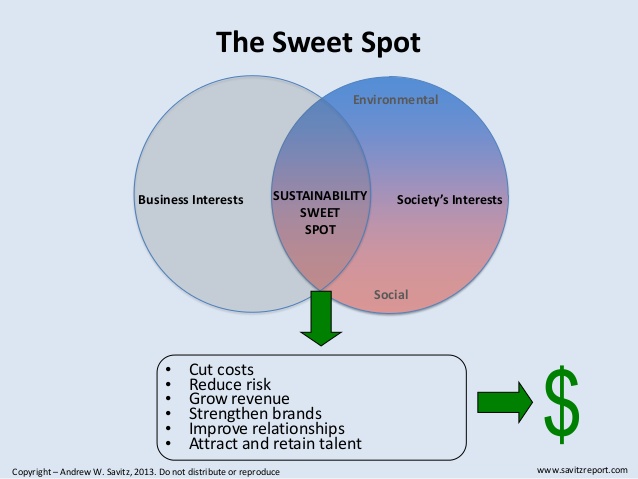Employees are what can make or break a company’s success, making human resources likely the most important department within a business. The competition revolving around finding the best talent and minds is increasing. With platforms like Linkedln, Indeed, and the rise of online applications with algorithms automatically filtering out applicants, recruiting employees has been brought to a whole new level.
However, companies are still going about hiring the wrong way. Many entrepreneurs don’t want to pay for the high expense of high talent. Therefore, companies settle for less to keep operation costs down. What is widely overlooked, is how much utilizing this method is actually costing businesses a loss in profits.
This is where finding a company’s “sweet spot” comes in. The sweet spot is an area where business interest (profit) meets the interest of the common good, ultimately creating a win win situation. Many company owners believe that investing in social responsibility, in this case employee benefits, may be a threat to company profits. This article explores where the sweet spot can be found by protecting the interests of both parties, benefitting both a business and employees. Cutting corners in human resources to save on operation costs will only hurt a company’s profits, as explained and proven below.
The first thing to consider when hiring new staff is that higher salaried, more talented employees end up paying for themselves. As advisor and former publisher of SUCCESS magazine, Darren Hardy put it, A-players are free, A-players being the best talent. Hardy acknowledges that instead of having a mindset that you can’t afford A-players, you actually can’t afford to not hire them because B or C-players are much more costlier.
“Whenever I ask top business leaders what they attribute to the success of their businesses to, invariably they say it’s the great team of people they have surrounded themselves with. This is not some self-effacing answer. Great leaders know businesses are nothing but a group of people brought together to accomplish a mission. The better the people, the better chance you have of accomplishing the mission. No CEO climbs to the top of the mountain alone- it requires a great team. Many of these extraordinary achievers will readily confess that most of their team is smarter, more talented, and more skilled than they are. In fact, they will tell you that is always their objective in hiring”.
Hardy, pg. 132
The second thing to consider is not just the money offered to employees, but making the work environment and benefits hard to walk away from. Three large companies that have long understood this financial value intertwined with ethics are Wegman’s, Ford, and PricewaterhouseCoopers (PwC). Consultant, Andrew Savitz, explores these company’s tactics and how they found their sweet spots in HR.
Wegmans
“The company offers higher-than-average wages, high-end training programs, college tuition assistance, and, perhaps most important, jobs designed to empower workers to make decisions to help customers. Wegman’s commitment to these practices is expensive: the company spends 15 to 17 percent of sales on labor cost as opposed to the industry average of 12 percent. Wegman’s has also spent more than $85 million in tuition assistance over the past twenty-nine years. But employee satisfaction creates sizable financial rewards for Wegman’s. The company’s costs related to turnover (for example, unemployment insurance, severance, training, lost productivity) are 6 percent of revenues compared to the industry average of 19 percent, which translates to a savings of approximately $300 million per year, far more than needed to cover the costs of the programs”.
(Savitz, pg. 50)
Ford
“When hourly wages for skilled workers ran as low as $.15, the company’s founder, Henry Ford, startled the world by announcing that he would pay a guaranteed daily wage of $5 to every worker, because ‘everyone who works at Ford should be able to afford the product he produces.’ It was a shrewd business move as well as a humane one. Labor turnover at Ford virtually disappeared, with the result that the company’s total personnel costs fell, enabling Ford to lower the price of a Model T while increasing profits”.
(Savitz, pg. 54-55)
PwC
“Internal PricewaterhouseCoopers (PwC) studies indicate that it cost the firm from two to three times annual salary to replace a manager when the full cost of recruitment, hiring, and training and of work distribution are considered. Thus, whenever a manager leaves, it’s as if PwC continues to pay that salary for at least two years. So the company’s excellent work-life balance, employee wellness, and partner-employee connectivity programs, all of which improve employee retention, serve to boost the firm’s profitability and the quality of client service while being recognized as responsible corporate behavior.
(Savitz, pg. 165)
Incorporating social responsibly into a company’s identity benefits a business’s profits, reputation, recognition, consumer perception and loyalty, as well as employee loyalty, productivity, and overall efficiency. The sweet spot found in corporate social responsibility is just one aspect of a company’s overall sustainability sweet spot. As Savitz sums it up, “it all adds up to a world in which attracting and retaining the best employees is more crucial to business success than ever. And sustainability is proving to be a vital tool in these efforts” (pg 68-68). The lesson to take away is to not skimp on salaries and employee benefits and only hire A-players. Investing in implementing sustainable business practices will be well worth it in the end.
Note: More sustainable business practices to incorporate in companies to gain profit will be explored in further blog posts. Stay tuned 🙂
References
Hardy, Darren. The Entrepreneur Roller Coaster. Dallas, SUCCESS, 2015
Savitz, Andrew and Weber, Karl. The Triple Bottom Line. San Francisco, Jossey-Bass, 2014






Leave a Reply